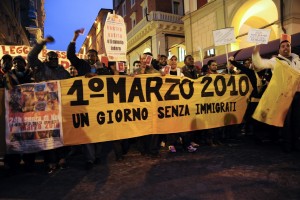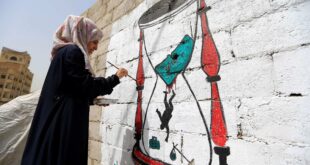by LUCA COBBE – GIORGIO GRAPPI
→ Italian
 At the Eve of the 1st of March 2016 against borders and precarization, thank to the comrades of trommons.org (lucipike, sara_portone, fravan561, P. Abzieher, A. Sarjanović), we publish the English translation of an essay on the strike of migrant labor of the 1st of March 2010, contained in the collection La normale eccezione. Lotte migranti in Italia, F. Mometti, M. Ricciardi (eds.), Rome, Alegre, 2011.
At the Eve of the 1st of March 2016 against borders and precarization, thank to the comrades of trommons.org (lucipike, sara_portone, fravan561, P. Abzieher, A. Sarjanović), we publish the English translation of an essay on the strike of migrant labor of the 1st of March 2010, contained in the collection La normale eccezione. Lotte migranti in Italia, F. Mometti, M. Ricciardi (eds.), Rome, Alegre, 2011.
Six years have passed since that experience of political insubordination that involved hundreds of thousands of men and women in several cities in Italy and beyond. It has been an experience that, no matter how rich of elements of innovation, already the year after proved itself impossible to be repeated. The political context and the activism scene, the relationship between migrants, unions and political forces, the public debate, but mainly the steady transformation that the migrants’ movements cause on the composition of society and labor force are not elements that can be easily predicted and reproduced. And yet, some elements of that experience continue to pose questions to all those that face the problem of political organization in a framework in which the processes of precarization are entangled with a transnational government of mobility.
In these six years there has been for sure a new wave of conflicts of migrant labor in the workplaces (see the struggles in the logistics sector), the final sunset of trade unions’ power f negotiation and the growth of the movements of millions of men and women challenging the borders to escape from war, poverty and exploitation. In the meanwhile precarity has established itself as the general condition of all labor. In this very different situation, migrant labor continues to hold a political centrality. It points at a specific tendency that concerns all contemporary living labor: its essential mobility. Mobility is all the more the general character of labor nowadays: it turns upside down both the labor market and the European institutions and it contributes to sharpen the crisis of the traditional forms of organization of labor, starting from the unions.
To recall the experience of 2010 strike of migrant labor is meaningful because it helps coping with these contradictions with the aim of thinking at new ways of political organization in front of a command on labor deployed in an increasingly global way. Against the myth of solidarity, to start from the strike means considering the task of overcoming the fragmentation without claiming to eliminate the differences that cross living labor. Against an imagination widespread among activists, according to which migrants exist only when they physically cross the borders, to start from the experiences of insubordination of migrant labor means understanding its capacity of bringing disorder in production and reproduction. Furthermore, considering how in 2010 the strike has been turned from a slogan into a reality is useful for looking at the many, too many resistances that back then the unions and social movements expressed against it. Those resistances are not, for us, the result of a simple clash between discourses or perspectives. They are the signal of an objective difficulty that migration and mobility pose to the political action and to the possibility of building really transnational processes of organization. While today it is widespread the tendency of seeing the «migrant question» as a matter of «welcoming», and migrants only as subjects of needs, to recall those resistances seems fruitful to grasp in its entirety the stake implied in the storm that hit Europe thank to the migrants.
To organize this mobility, to grasp its contradictions, its potential of destabilization was the political challenge of the strike of migrant labor of 2010. To recognize in migrant labor the possibility of politicizing a specific difference that criss-crosses the transnational space of contemporary labor is the challenge that can still open unprecedented scenarios. This challenge has been taken up by the Transnational Social Strike Platform that, on the wave of the 2010 strike of migrant labor, decided to turn the 1st of March 2016 into the first step of a process that has the ambitious aim of building the conditions of a wide and powerful transnational strike, capable both of contrasting the transnational government of mobility and to interrupt the global chains of exploitation.
→ Download the article as a *pdf
***
«On March 1st the migrants will have their first strike»
March 1st was «the first strike of thousands of migrants and Italians against the exploitation of migrant labor, spread across a vast region»[i]. March 1st, 2010 was certainly more than just that. At least 300,000 people filled the streets of dozens of Italian cities: from Trieste to Syracuse, from Palermo to Turin, including large demonstrations in Milan, Naples, Brescia and Bologna. In various small Italian cities, possibly for the first time, the widespread presence of migrants in the social fabric was demonstrated through picket lines or rallies. These assumed a communal tone of refusal of the dominant discourse, connecting racism to that which is commonly defined today as institutional racism.
Even if this was the only result achieved by this act of mobilization, there would be something to cheer about. Criticism of institutional racism had in fact even penetrated certain academic environments, such as a large section of civil society associations, which for years had used the lenses of multiculturalism, immigration, or volunteerism through which to view the migrant presence. The double effect of these approaches had been to depoliticize the presence of the migrants and to relegate racism to the level of a purely social phenomenon, as if society itself can be considered neutral in respect to the various results of State laws[ii].
The eruption of migrants as individuals and key players on the scene had then broken open, at least for a day, the cage created by solidarity against subjects considered to be weaker, in need of help and constantly withdrawn into the centre of their communities organized by nation. This allowed for a glimpse at the political potential of the migrant presence[iii]. A cage, as we should note, that was attacked on all sides in the last ten years, but whose presence was difficult not to notice even in the discussions and courses of action that led to the last large anti-racist protest on October 17, 2009. This protest brought out tens of thousands of people to Rome and showed the limit of the discussion and of anti-racist activism. A political limit, in the true sense of the term, and not simply a limit of will on the part of the collective subjects is what that protest brought together. For those who watched or were active in the series of mobilizations of migrants and anti-racists that took place in Italy over the past years, that protest can be considered a swan song in some ways. The large migrant presence in the piazza, which in 2004 and 2005 expressed itself disruptively, was now starting to indicate that such behaviour, maybe, wasn’t needed any longer: the numbers that came out on October 17 indicated neither a new piece of data nor an expression of a need for attention, but instead established the mobilization as a challenge against the same old discourse and anti-racist practices.
Therefore it is not a surprise that a break in a long series of mobilizations happened in the most unusual and unexpected way: by means of a «wake up call» originating from France, and taken up as such by the press, then spread further on Facebook, including in Italy (where first it was looked upon with condescension by many of those that were privy to the plans of the migrants mobilization), then it was accepted. Finally the message had the power of massive circulation, shared between the thousands of migrant women and accepted by social movements. Change was present even in the piazzas where only a few dozen people came out, as they found themselves de facto connected to the other thousands of people that were striking and protesting in Italy. Paraphrasing the words of an Egyptian protester, which were reported by a few newspapers during the days in Tahrir Square, if before the migrants were watching television, that day it was the television that was watching the migrants. It is certainly true that the migrants had never been «in front of the camera», but on March 1st a development was produced that was capable of modifying perspectives. The connection between the previous struggles and protests and this development needs to be understood.
The events were made possible thanks to a series of factors, first of all, the fact that for weeks a phrase circulated on the Internet, on social networks, and in the national press, which exercised a strong pull and had the ability to pull in, in a manner of speaking, very diverse subjects: «On March 1st the migrants will have their first strike»[iv]. Speaking of a strike in relation to March 1st served to make it known that, even where there was no strike, that day would represent an occasion of new and powerful mobilization.
The word strike was put into circulation and then it was discussed: on the one hand, it provoked misunderstandings, hasty declarations, legal analysis – before, it should be noted, of the renewed debate that this word created a few months prior as a result of the FIAT referendum in Pomigliano – and even distancing. On the other hand, some groups decided to build a mobilization in order to organize a real strike: they found a widespread desire on the part of the migrants to be key players, for the first time, of a strike that would be their own. The desire on the part of the migrants to lead a strike was not new, the novelty was instead the limelight and the fact that this strike was, in a way, announced. No one knew where it was coming from, but the phrase was circulating: «On March 1st the migrants will have their first strike».
There were different interpretations of the strike, in fact many interpretations, even between those who then were at the time key players in the organization of the day, asserting simultaneously that it was impossible or at least insufficient in respect to the questions concerning the migrant condition. The topic that stands between these two sides in apparent contradiction was that of work: sustaining the impossibility of a migrants’ strike would’ve meant in the first place considering the barriers of exploitation and migrants’ subjection to racism, both institutional and not, insurmountable. Supporting the insufficiency of the strike meant saying instead that precisely due to these obstacles the strike couldn’t bring the diversification of the migrant condition to light. Many, searching to distance its link to the labor aspect, therefore neutralized the world strike. The unsaid that was implicit in these discussions brought together a diverse set of participants, livening up large debates and encouraging them to take a stand. The collective components immediately called to the cause were mainly two: the unions on one side, and different associations, groups, and protest groups occupied with the subjects of anti-racism or, more generally, of migration on the other. Neither side understood that the problems that were signified were exactly what was at stake on March 1st, for those who wanted to accept the political challenge…scarica il pdf per continuare a leggere….
[i] Coordinamento per lo sciopero del lavoro migrante in Italia. The Coordinamento worked as an umbrella coordination between migrant organizations, collectives, and networks from Bari, Bologna, Brescia, Mantua, Milano, Padova, Roma, and Torino. The document can be viewed at http://lavoromigrante.splinder.com/post/22353749/come-si-racconta-il-primo-marzo. On the political category of the “migrant labor” we refer to the introduction of F. Raimondi, M. Ricciardi to Lavoro migrante. Esperienza e prospettiva, (edited by F. Raimondi e M. Ricciardi), Derive/Approdi, Rome, 2004, p. 5-21.
[ii] See the article by Ranciere, Il razzismo viene dall’alto, published in «il Manifesto» from 9/26/2010. http://www.sinistrainrete.info/societa/1029-jacques-ranciere-il-razzismo-viene-dallalto.
[iii] When speaking about individuals we intend, instead of giving a definition, to highlight a problem. That which permits us to indicate the rupture that the migrant behavior causes both on the institutional and social borders that they cross as well as in respect to every position that is presumed to be “natural”, as in religion or the community, and the excess that they convey. As stated by Devi Sacchetto, «The singular character of every individual indicates that they express themselves in the world around them through social relationships based on the uniqueness that they represent and that they, willingly or not, drag along behind them.» The disassembly of community order however doesn’t signify a «complete recognition of the worth of the individual», but instead the entrance in «standardized uniforms» that are a de facto «reduction and downsizing of the expectations and possibilities of the individual». For the migrants these factors, especially in the formation of social relationships, «place them outside of the natural proximity for those relationships that are mostly based on socialization at work and choosing from friendships near or far». This topic is discussed in D. Sacchetto, Il Nordest e il suo Oriente. Migranti, capitali e azioni umanitarie, Verona, ombre corte, 2004, pp. 19-44.
[iv] Various formulas were utilized: strikes by foreigners, immigrants, migrants, 24 hours without us. It was significant the choice of a right-wing newspaper «il Giornale», which on 1/21/2010, writing about the mobilization and unions’ opposition to call a strike, titled Immigrati: il sindacato vieta lo sciopero ai negri (Immigrants: the union forbids negroes to strike).
 ∫connessioniprecarie connettere gli ∫connessi, produrre comunicazione
∫connessioniprecarie connettere gli ∫connessi, produrre comunicazione




